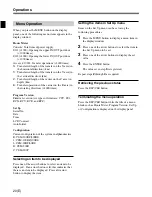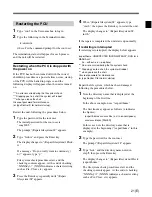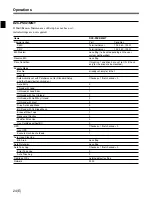
21(E)
Restarting the PCU
1
Type “root” in the Username box to log in.
2
Type the following in the Terminal window.
# /sbin/init 6
where # is the command prompt for the root user.
The termination status will appear for each process,
and the unit will be restarted.
Restarting when the PCU is stopped with
the power on
If the PCU has not been turned off with the correct
shutdown procedure or a power failure occurs, startup
of the PCU will be halted in progress, and the
following display will appear when the unit is turned
on:
*** An error occurred during the file system check.
*** Dropping you to a shell; the system will reboot
*** when you leave the shell.
Give root password for maintenance
(or type Control-D for normal startup):
Restart the unit, following the procedures below.
1
Type the password for the root user.
The initial password for the root user is
“sony2002.”
The prompt “(Repair filesystem)1#” appears.
2
Type “fsck-A” and press the Enter key.
The display changes to “(Repair filesystem)1#fsck-
A.”
If a message “Do you really want to continue (y/
n)?” appears, type “y.”
File system check procedures start, and the
checking contents appear. At the end of checking,
“XXXX<y>?” (XXXX indicates a character string
such as Fix, Clear, etc.) appears.
3
Press the Enter key repeatedly until “(Repair
filesystem)2#” appears.
4
When “(Repair filesystem)2#” appears, type
“init 6,” then press the Enter key to restart the unit.
The display changes to “(Repair filesystem)2#
init 6.”
If the repair is completed, the unit starts up normally.
If restarting is interrupted
If restarting is interrupted, the display below appears:
/export/home: UNEXPECTED INCONSISTENCY; RUN fsck
MANUALLY.
(i.e., without –a or –p options)
*** An error occurred during the file system check.
*** Dropping you to a shell; the system will reboot
*** when you leave the shell.
Give root password for maintenance
(or type Control-D for normal startup)
Repair the file system, which has been damaged,
following the procedures below.
1
Note the directory name that is displayed at the
beginning of the first line.
In the above example, note “/export/home.”
The first line may appear as follows (x indicates
the figures):
/export/home:xxxx/xxxx files (x.x% non-contiguous),
xxxx/xxxx blocks [FAILED]
In this case, note the directory name that is
displayed at the beginning (“/export/home” in this
example).
2
Type the password for the root user.
The prompt “(Repair filesystem)1#” appears.
3
Type “fsck” and the directory name noted in
step
1
, then press the Enter key.
The display changes to “(Repair filesystem)1#fsck
/export/home.”
The file system check procedures start, and the
checking contents appear. At the end of checking,
“XXXX<y>?” (XXXX indicates a character string
such as Fix, Clear, etc.) appears.























